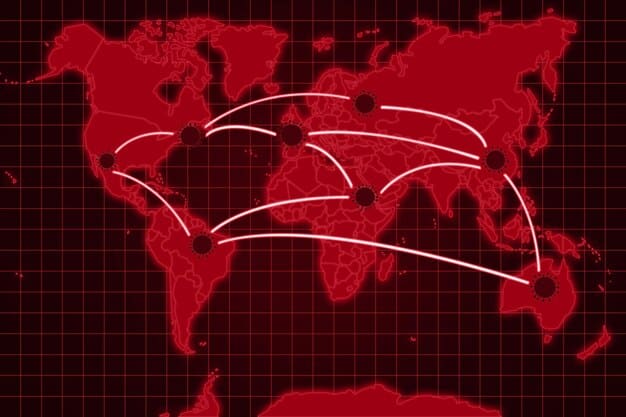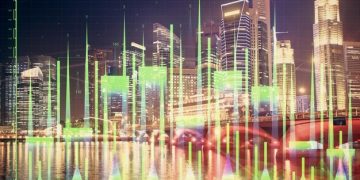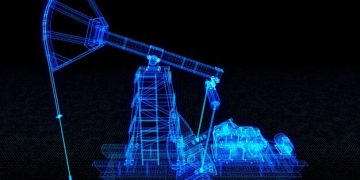Supply Chain Disruptions: US Economic Impact in 2025

The lingering effects of supply chain disruptions are projected to persist into 2025, continuing to influence the US economy through elevated inflation, constrained production across sectors, and a re-evaluation of global sourcing strategies amidst ongoing geopolitical and climactic instability.
In recent years, the global economy has grappled with unprecedented shocks, fundamentally altering the flow of goods and services. A central question for economists, businesses, and consumers alike is: Supply Chain Disruptions: How Are They Still Affecting the US Economy in 2025? This article delves into the persistent impacts and evolving landscape of these critical economic arteries.
The Enduring Legacy of Pandemic-Era Pressure
The initial shockwaves of the COVID-19 pandemic exposed the fragility of highly optimized, just-in-time supply chains. While the immediate crisis has subsided, its systemic effects continue to reverberate, reshaping how goods move and how businesses plan. The expectation in 2025 is not a return to pre-pandemic normality, but rather a new equilibrium defined by increased caution and diversification.
The abrupt shifts in consumer demand, coupled with labor shortages and lockdowns, created a bottleneck that continues to impact various sectors. Manufacturers face ongoing challenges in securing raw materials and components, leading to production delays and higher input costs. This ripple effect extends downstream, affecting retail prices and consumer purchasing power.
Persistent Logistical Bottlenecks
Even with some easing, global shipping networks remain under pressure. Port congestion, while not as severe as its peak, still contributes to delays and increased freight costs. The movement of goods through inland transit points also presents challenges, with trucking capacity and warehouse space remaining tight in key regions.
- Increased transit times for imported goods.
- Higher freight rates impacting profitability.
- Difficulty in forecasting delivery schedules accurately.
- Strain on trucking and warehousing infrastructure.
These logistical hurdles translate directly into higher operating expenses for businesses, which are often passed on to the consumer in the form of elevated prices, contributing to inflationary pressures. The interconnectedness of these systems means that even minor disruptions can have cascading effects across multiple industries and geographic areas.
Moreover, the war in Ukraine and other geopolitical tensions have further complicated global trade routes, diverting existing capacities and forcing businesses to seek alternative, often less efficient, pathways. This re-routing contributes to the chronic nature of these disruptions, embedding them deeper into the operational fabric of international commerce.
Labor Market Dynamics
Beyond physical infrastructure, the labor market plays a critical role in supply chain resilience. Shortages of truck drivers, warehouse workers, and port employees continue to plague the system. This scarcity drives up wages and often necessitates overtime, further increasing operational costs. Companies are investing in automation, but the transition is slow and not a complete substitute for human labor in many roles.
The “Great Resignation” and shifts in worker preferences have left many critical roles unfilled, exacerbating existing bottlenecks. Attracting and retaining talent in logistics and transportation remains a significant challenge for companies striving to maintain efficient operations.
Understanding these enduring legacies is crucial for businesses and policymakers. The path forward requires adaptive strategies, acknowledging that the global supply chain environment has fundamentally changed and will necessitate robust, diversified approaches for continued economic stability.
Inflationary Pressures and Consumer Impact
The most tangible and immediate impact of supply chain disruptions on the US economy has been persistent inflation. When the flow of goods is constrained, demand often outstrips supply, leading to price increases. This phenomenon has been a defining characteristic of the post-pandemic economic landscape, and its influence is projected to remain significant in 2025.
While the peak of inflationary surges might be behind us, the underlying structural issues contributing to higher prices driven by supply chain inefficiencies are unlikely to disappear entirely. Businesses facing higher costs for raw materials, transportation, and labor often pass these increases on to consumers, eroding purchasing power and impacting household budgets.
Sector-Specific Price Hikes
Certain sectors have been disproportionately affected. The automotive industry, for instance, continues to grapple with semiconductor shortages, leading to fewer vehicles produced and higher prices for both new and used cars. Similarly, electronics, certain food products, and construction materials have seen sustained price increases due to supply-side issues.
The housing market also feels the pinch through elevated costs for building materials like lumber, steel, and concrete, affecting both new constructions and renovation projects. This broad-based impact means that inflation isn’t confined to a few isolated product categories but permeates daily living costs for the average American family.
Erosion of Purchasing Power
For consumers, persistent inflation means that their dollar buys less. While wages have risen for many, these gains have often been offset by the rapid increase in the cost of living. This erosion of purchasing power can lead to reduced discretionary spending, impacting retail sales and the broader service economy. Families may be forced to make difficult choices about their expenditures, prioritizing necessities over luxuries.
- Higher prices for everyday goods and services.
- Decreased real wages for many workers.
- Reduced consumer confidence and spending.
- Increased need for personal savings to combat rising costs.
The Federal Reserve’s efforts to combat inflation through interest rate hikes have had a cooling effect on demand, but they cannot fully address supply-side constraints. The interplay between monetary policy and persistent supply chain issues creates a complex economic environment where traditional remedies have limited efficacy alone.
Businesses, in turn, are forced to navigate a challenging landscape of unpredictable input costs and consumer sensitivity to price changes. This often leads to difficult decisions regarding pricing strategies, production volumes, and profit margins, further contributing to the economic uncertainty projected for 2025.
Reshoring, Nearshoring, and Diversification Strategies
One of the most significant shifts driven by supply chain fragility is the accelerating trend of reshoring and nearshoring. Companies, once heavily reliant on cost-effective but geographically distant production hubs, are now prioritizing resilience and proximity. This strategic pivot aims to reduce vulnerabilities by bringing manufacturing closer to end markets or diversifying production across multiple regions.
The motivation extends beyond just operational efficiency; it also encompasses geopolitical risks, intellectual property protection, and a desire for greater control over the entire production process. While a complete reversal of globalization is unlikely, a significant recalibration of supply chain geography is well underway.
Bringing Production Closer to Home
Reshoring involves bringing manufacturing back to the US, a move supported by government incentives and a recognition of the strategic importance of domestic production capabilities. This can stimulate job growth and strengthen industrial bases within the country, particularly in critical sectors like semiconductors, pharmaceuticals, and renewable energy components.
Nearshoring, on the other hand, involves relocating production to neighboring countries, such as Mexico or Canada, leveraging geographic proximity and established trade agreements. This offers many of the benefits of reshoring in terms of reduced transit times and greater oversight, often at a lower cost than full reshoring to the US.
- Reduced vulnerability to geopolitical tensions.
- Shorter lead times for product delivery.
- Enhanced quality control and oversight.
- Potential for job creation in domestic and nearshore regions.
These strategies, however, are not without their challenges. They often involve higher labor costs, significant capital investment in new facilities, and the need to rebuild specialized industrial ecosystems. The transition is gradual and requires careful planning and execution.

Diversification as a Key Risk Mitigation
Beyond geographical shifts, companies are also implementing broader diversification strategies. This involves avoiding single points of failure by having multiple suppliers for critical components, even if it means sacrificing some short-term cost efficiencies. The emphasis is on building redundancy and flexibility into the system.
Investing in advanced technologies like artificial intelligence and big data analytics also plays a role in enhancing visibility across complex supply chains, enabling companies to identify potential disruptions earlier and react more proactively. This data-driven approach is becoming indispensable for effective risk management.
By 2025, it is expected that a significant portion of US companies will have already diversified their supply chains to some extent, making the overall economy more resilient to future shocks, even if it means slightly higher costs for some goods.
Technological Innovation as a Solution
In response to the persistent challenges, technological innovation is emerging as a critical enabler of greater supply chain resilience and efficiency. From artificial intelligence (AI) and machine learning (ML) to blockchain and the Internet of Things (IoT), these advancements are transforming how goods are tracked, managed, and moved, offering sophisticated tools to navigate complexity.
The integration of these technologies promises to enhance visibility across vast supply networks, improve forecasting accuracy, and automate critical processes, thereby reducing human error and speeding up response times to unforeseen events. Businesses are increasingly recognizing that future competitiveness hinges on smart, tech-infused logistics.
AI and Predictive Analytics
AI and machine learning algorithms are being deployed to analyze vast datasets related to weather patterns, geopolitical events, demand fluctuations, and supplier performance. This allows for more accurate predictive modeling of potential disruptions, enabling companies to proactively adjust their strategies, reroute shipments, or pre-order inventory.
Predictive analytics can identify weak links in the supply chain before they break, offering insights into inventory optimization and capacity planning. This shift from reactive problem-solving to proactive risk management is a game-changer for businesses aiming for uninterrupted operations in 2025 and beyond.
Blockchain for Transparency and Trust
Blockchain technology, known for its decentralized and immutable ledger, offers a new level of transparency and traceability throughout the supply chain. By recording every transaction and movement of goods, blockchain can verify the authenticity of products, track their origin, and simplify compliance procedures. This is particularly valuable for industries where provenance and ethical sourcing are paramount.
- Enhanced traceability of goods from origin to destination.
- Improved trust among supply chain partners.
- Reduced instances of fraud and counterfeiting.
- Streamlined documentation and compliance processes.
While still in relatively early stages of broad adoption, the potential of blockchain to build more resilient and trustworthy supply chains is immense. It allows for clearer accountability and quicker identification of issues when they arise, fostering greater collaboration among disparate entities.
IoT and Enhanced Visibility
The Internet of Things (IoT) involves embedding sensors into products, vehicles, and warehouse equipment to collect real-time data on location, condition, and environment. This constant stream of information provides unprecedented visibility into the movement and status of goods, allowing for immediate intervention in case of delays or damage.
From monitoring temperature-sensitive cargo to tracking the precise location of a shipping container, IoT sensors provide the granular data necessary for optimized logistics and rapid response to disruptions. Combined with AI, IoT data enables truly intelligent supply chain networks that can adapt and self-correct with minimal human intervention.
By leveraging these technological advancements, the US economy is building a more intelligent, resilient, and adaptive supply chain infrastructure, reducing its susceptibility to future shocks and fostering sustained growth.
Government Policy and International Cooperation
Recognizing the profound impact of supply chain disruptions on national security and economic stability, governments worldwide, including the US, have become more actively involved in shaping supply chain resilience. This involves a mix of domestic policy initiatives, international partnerships, and strategic investments aimed at fortifying critical economic pathways.
The shift represents a tacit acknowledgment that relying solely on market forces may not be sufficient to address systemic vulnerabilities exposed by recent crises. By 2025, a more coordinated and policy-driven approach to supply chain management is expected to be a defining feature of the global economic landscape.
Strategic Domestic Investments
In the US, legislative actions like the CHIPS and Science Act reflect a commitment to bolstering domestic manufacturing in key sectors, particularly semiconductors. Such policies aim to reduce reliance on foreign sources for essential components, thereby mitigating geopolitical risks and ensuring access to crucial technologies.
Beyond semiconductors, there’s growing interest in supporting domestic production of critical minerals, pharmaceuticals, and clean energy components. These investments are designed to create more diversified and secure supply sources within national borders, fostering long-term economic stability and technological leadership.
- Funding for domestic manufacturing of critical goods.
- Incentives for reshoring and nearshoring initiatives.
- Investment in vocational training for skilled labor.
- Development of strategic reserves for essential materials.
These policy interventions are not just about building new factories; they also involve investing in infrastructure, research and development, and workforce training to create a robust and self-sufficient industrial base capable of absorbing future shocks.

Fostering International Partnerships
While domestic production is important, global supply chains remain a reality. Therefore, international cooperation is equally vital. The US is engaging in bilateral and multilateral dialogues to create more resilient and diverse supply networks with trusted allies. This involves sharing information, coordinating standards, and establishing secure trade corridors.
Agreements focused on early warning systems for disruptions, collaborative efforts in R&D for new materials, and joint investment in critical infrastructure overseas are becoming more common. The goal is to create a network of reliable partners that can collectively withstand and recover from various types of shocks, from natural disasters to geopolitical tensions.
These government-led initiatives, both domestically and internationally, are laying the groundwork for a more robust and responsive supply chain ecosystem by 2025. They signify a proactive approach to economic security, recognizing the interconnectedness of global trade and the need for collective action to manage its vulnerabilities.
Shifting Business Models and Practices
The persistent threat of supply chain disruptions is compelling businesses of all sizes to fundamentally rethink their operational models and adopt more agile, resilient practices. The traditional emphasis on lean, cost-saving strategies is being balanced with a new focus on redundancy, flexibility, and adaptability. This paradigm shift affects everything from inventory management to supplier relationships and product design.
Companies are moving away from the “just-in-time” approach exclusively towards a “just-in-case” philosophy for critical components, building buffers and diversifying risks. This strategic pivot is more than a temporary fix; it represents a long-term evolution in how successful enterprises will operate within a more volatile global environment.
Embracing Redundancy and Flexibility
Businesses are increasingly investing in redundant capabilities, whether it’s through multiple production sites, holding higher buffer stocks of key materials, or having a wider network of approved suppliers. While this may incur higher costs in the short term, the long-term benefit of avoiding catastrophic production halts due to single points of failure is seen as a worthwhile investment.
Flexibility in manufacturing processes, such as the ability to quickly reconfigure production lines for different products or components, is also becoming a priority. Modular designs and adaptable assembly lines allow companies to adjust to sudden shifts in demand or supply availability more readily.
Strengthening Supplier Relationships
The era of treating suppliers merely as commodity providers is fading. Companies are increasingly forming deeper, more collaborative partnerships with their key suppliers. This involves greater transparency, shared risk assessment, and long-term contracts that foster mutual trust and resilience. Understanding the supply chain of their suppliers is also becoming a critical focus to identify potential cascading risks.
- Building deeper, more transparent relationships with key suppliers.
- Implementing diversified sourcing strategies.
- Investing in buffer stocks of critical components.
- Developing agile manufacturing and distribution capabilities.
This shift aims to create more robust and responsive supply networks where communication and preemptive problem-solving are paramount. Shared visibility into production schedules and inventory levels can prevent small issues from escalating into major disruptions.
Localization and Regional Focus
Beyond formal reshoring, many companies are adopting a more localized approach to their operations, focusing on regional supply networks for certain products or markets. This can involve setting up smaller, decentralized manufacturing hubs closer to end consumers, reducing reliance on lengthy international shipping routes for all components.
This localized strategy not only shortens lead times but also makes supply chains less susceptible to global shocks, allowing businesses to adapt more quickly to regional market demands and regulatory changes. By 2025, these transformed business models and practices are expected to contribute significantly to the overall resilience of the US economy, though the journey towards full optimization remains dynamic and continuous.
| Key Point | Brief Description |
|---|---|
| ⛓️ Persistent Bottlenecks | Ongoing logistical and labor issues continue to impact global shipping and production efficiency, causing delays and higher costs. |
| 💸 Inflationary Pressure | Higher input costs from disruptions are passed to consumers, sustaining elevated prices and eroding purchasing power into 2025. |
| 🌍 Reshoring & Diversification | Companies are relocating production closer to home and diversifying suppliers to enhance resilience and reduce geopolitical risks. |
| 🤖 Tech Integration | AI, IoT, and blockchain are increasingly used to improve supply chain visibility, predictability, and efficiency in a volatile environment. |
Frequently Asked Questions About Supply Chain Impact
While some acute disruptions have eased, a full resolution is unlikely. The global supply chain environment in 2025 is characterized by a new normal of increased volatility due to geopolitical factors, climate change, and persistent labor shortages, requiring ongoing adaptation by businesses and governments.
Consumers directly experience higher prices for goods due to increased production and transportation costs. This persistent inflation erodes purchasing power, makes everyday necessities more expensive, and can lead to reduced discretionary spending as household budgets become tighter.
Governments are actively involved through strategic domestic investments, like the CHIPS Act, to reshore critical manufacturing. They also foster international cooperation to diversify sourcing and build resilient trade partnerships, aiming to reduce external dependencies and strengthen national economic security.
Absolutely. Businesses are shifting from purely lean, just-in-time models to “just-in-case” strategies that prioritize resilience. This includes diversifying suppliers, building buffer inventories, investing in nearshoring or reshoring, and adopting advanced technologies like AI to improve visibility and adaptability in their operations.
Technology is crucial. AI and machine learning enhance predictive analytics for potential disruptions, while IoT provides real-time tracking and visibility. Blockchain improves traceability and trust. These innovations help businesses anticipate, react faster, and operate more efficiently within complex and often unpredictable global networks.
A Resilient Path Forward in a New Economic Era
The question of how supply chain disruptions are still affecting the US economy in 2025 reveals a complex and evolving landscape. What began as a series of acute shocks has transformed into systemic shifts in how goods are produced and delivered globally. The residual effects are evident in persistent inflationary pressures, the strategic reorientation of businesses towards resilience, and increased governmental intervention aimed at securing critical supply lines. While a complete return to pre-pandemic operational norms may not be on the horizon, the ongoing adaptation through technological innovation, strategic diversification, and enhanced international cooperation suggests a future where the US economy is better equipped to navigate the inherent volatility of global trade, fostering a more robust and adaptive economic environment.





